Fall of Saigon 40th anniversary

NICK UT/AP PHOTO
The fall of Saigon, April 30, 1975, marked the end of the Vietnam War and the capture of Saigon by North Vietnamese forces. Chaos ensued as the North Vietnamese advanced southward leading to that momentous event 4o years ago. In the days before the fall of Saigon, all American military and civilians were evacuated along with thousands of South Vietnamese in Operation Frequent Wind, the largest helicopter evacuation in history.
In this photo, a Roman Catholic priest helps an elderly villager brave the windy rotor blast from a government helicopter as they run to board it from west of Tuy Hoa in Vietnam, March 27, 1975. They were among thousands of refugees from the Central Highlands who were picked up along the central coast.

NICK UT/AP PHOTO
A South Vietnamese tank loaded with troops rumbles past a destroyed hamlet on Highway 22 following record fighting in the area about 60 miles northwest of Saigon. Officials said government reinforcements were rushed to Hieu Thien in an effort to retake outposts and villages that fell to the North Vietnamese, March 17, 1975.
Fall of Saigon

PHUOC/AP PHOTO
Nowhere to go and nothing to do, South Vietnamese refugees from Hue and the northern provinces pause on the dock waiting for the government to relocate them to the central coastal area at Da Nang in Vietnam, March 28, 1975.
Fall of Saigon
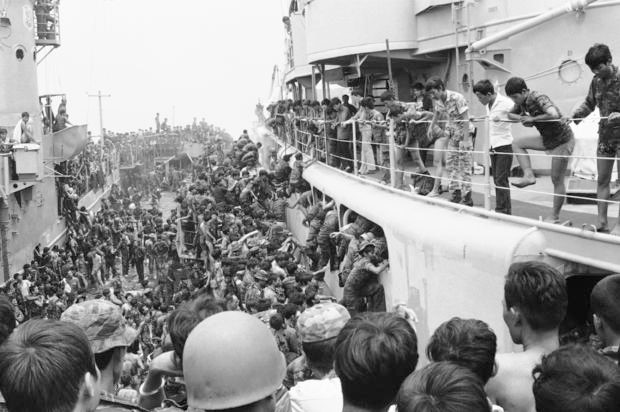
AP PHOTO
South Vietnamese Marines leap in panic aboard a cutter from an LST in Danang Harbor in Da Nang, Vietnam, April 1, 1975 as they are evacuated from the city, shortly before its fall to the Viet Cong and North Vietnamese. Cutters in turn hauled them south to Cam Ranh Bay.
Fall of Saigon

AP PHOTO
A U.S. civilian pilot in the aircraft doorway tries to maintain order as panicking South Vietnamese civilians scramble to get aboard during evacuation of Nha Trang, April 1, 1975. Thousands of civilians and South Vietnamese soldiers fought for space on the aircraft to Saigon as communist forces advanced following the fall of Qui Nhon, to the north.
Fall of Saigon

KY MHAN/AP PHOTO
A South Vietnamese father carries his son and a bag of household possessions as he leaves his village near Trang Bom on Route 1 northwest of Saigon, April 23, 1975. The area was becoming politically and militarily unstable as communist forces advanced, just days before the fall of Saigon.
Fall of Saigon

NATIONAL ARCHIVES/AFP/GETTY IMAGES
U.S. President Gerald Ford, Secretary of State Henry Kissinger and Vice President Nelson Rockefeller discuss the evacuation of Saigon at the White House in Washington, D.C., April 28, 1975.
Fall of Saigon

NATIONAL ARCHIVES/AFP/GETTY IMAGES
U.S. President Gerald Ford (C) and U.S. Secretary of State Henry Kissinger(L) are briefed by National Security Adviser Brent Scowcroft (R) on the evacuation of Saigon, April 28, 1975 at the White House in Washington, DC.
Fall of Saigon
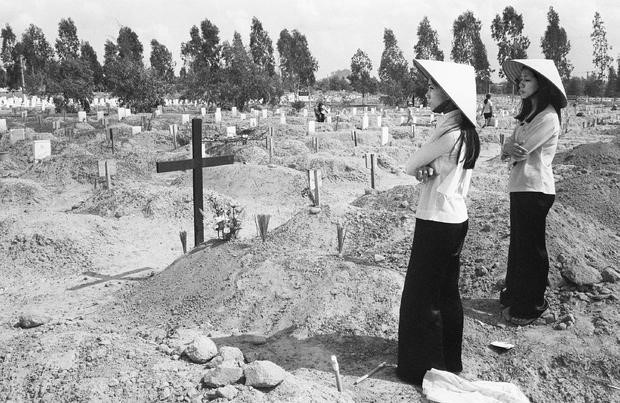
FRANCOISE DEMULDER/AFP/GETTY IMAGES
Two Vietnamese women mourn their relatives April 29, 1975 at Bien Hoa military cemetery as the U.S. started to evacuate their embassy in Saigon, ending the U.S.'s 15-year involvement in Vietnam.
Fall of Saigon

AP PHOTO
Americans and Vietnamese run for a U.S. Marine helicopter in Saigon during the evacuation of the city, April 29, 1975.
Fall of Saigon

FRANCOISE DEMULDER/AFP/GETTY IMAGES
Vietnamese civilians wait in front of the U.S. embassy in Saigon for visas to live in the United States two days before the fall of the city to North Vietnam communist forces, April 28, 1975,
Fall of Saigon
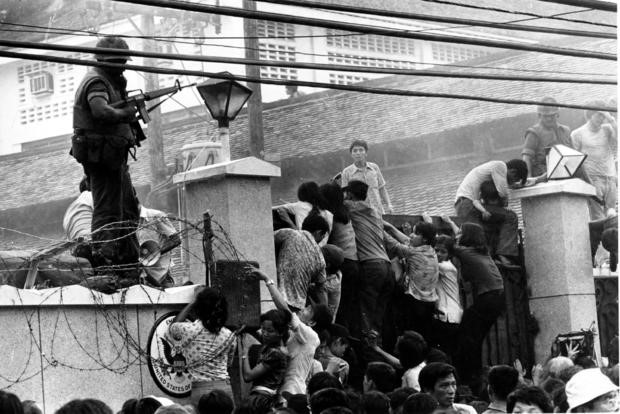
NEAL ULEVICH/AP PHOTO
Mobs of Vietnamese people scale the wall of the U.S. Embassy in Saigon, Vietnam, trying to get to the helicopter pickup zone, just before the end of the Vietnam War, April 29, 1975.
Fall of Saigon - evacuation

CBS NEWS
In this video still, a group of people scale a stairway to a CIA helicopter on a rooftop in Saigon, April 29, 1075.
The black and white photo of this event by Dutch photojournalist Hugh Van Es became an iconic image of the war, symbolizing a desperate U.S. withdrawal from Vietnam.
The location of this evacuation has often been identified as the rooftop of the U.S. embassy, but in fact it wasn't. The people in the photo were on a rooftop of an apartment building housing CIA officials and their families.
Fall of Saigon

AP PHOTO
U.S. Navy personnel aboard the USS Blue Ridge push a helicopter into the sea off the coast of Vietnam in order to make room for more evacuation flights from Saigon, April 29, 1975.
Fall of Saigon

AP PHOTO
An injured South Vietnamese war veteran limps away on a crutch with food looted from abandoned U.S. installations after evacuation of Saigon, April 29, 1975.
Fall of Saigon

NATIONAL ARCHIVES/AFP/GETTY IMAGES
The air evacuation of siege-stricken Vietnamese from Saigon to the U.S. was conducted after the Babylift operation. Vietnamese military and civilians await their C-41 journey during a stopover, in Utapo RTNAF, Thailand, April 29,1975.
Fall of Saigon

AP PHOTO
A South Vietnamese mother and her three children crouch on the deck of an amphibious command ship being plucked out of Saigon by U.S. Marine helicopters in Vietnam, April 29, 1975.
The war ended on April 30, 1975, with the fall of Saigon, now known as Ho Chi Minh City, to communist troops from the north.
Fall of Saigon

NEAL ULEVICH/AP PHOTO
People try to scale the 14-foot wall of the U.S. Embassy in Saigon, trying to reach evacuation helicopters, as the last of the Americans depart from Vietnam, April 29, 1975.
The war ended April 30, 1975, with the fall of Saigon, now known as Ho Chi Minh City, to communist troops from the north. Neal Ulevich/AP Photo
Fall of Saigon

AP PHOTO
South Vietnamese civilians try to scale the 14-foot wall of the U.S. embassy in Saigon, trying to reach evacuation helicopters as the last Americans departed from Vietnam, April 29, 1975.
More than two bitter decades of war in Vietnam ended with the last days of April 1975.
Fall of Saigon

AFP/AFP/GETTY IMAGES
A North Vietnamese communist tank driving through the main gate of the presidential palace of the U.S.-backed South Vietnam regime as the city falls into the hands of communist troops April 30, 1975.
Fall of Saigon

AFP/AFP/GETTY IMAGES
A line of captured U.S.-backed South Vietnamese Army soldiers are escorted by Vietnamese communist soldiers as they walk on a Saigon street after the city fell into the hands of the communist troops on the same day, April 30, 1975.
Fall of Saigon
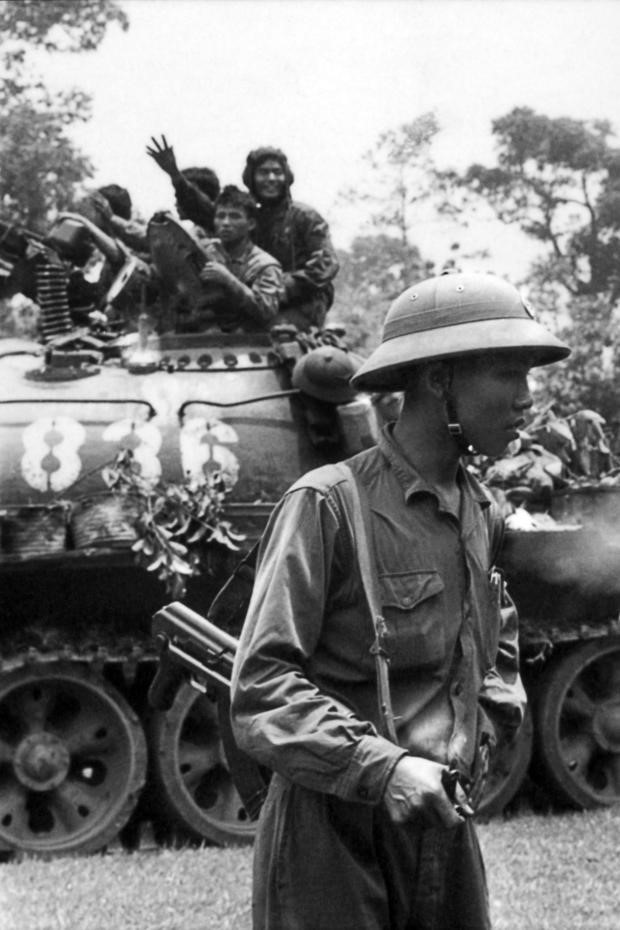
PHAN KHAC DUONG,PHAN THANK GIAN/VNA/AFP/GETTY IMAGES
Tanks of the North Vietnamese Army (NVA) forces take over the South Vietnamese presidential palace April 30, 1975, South Vietnamese government's last stronghold.
Fall of Saigon

AFP/GETTY IMAGES
North Vietnamese soldiers sit on top of a tank posted in front of the presidential palace of the U.S.-backed regime as hundreds of Saigon residents gather around after the city falls to communist troops on the same day, April 30, 1975.
Fall of Saigon

NAYAN CHANDA/AFP/GETTY IMAGES
A communist soldier at the Independence Palace in Saigon, April 30, 1975.
April 30, 2015 marks the 40th anniversary of the fall of Saigon to North Vietnamese forces and the subsequent toppling of the U.S.-supported southern regime.
Fall of Saigon
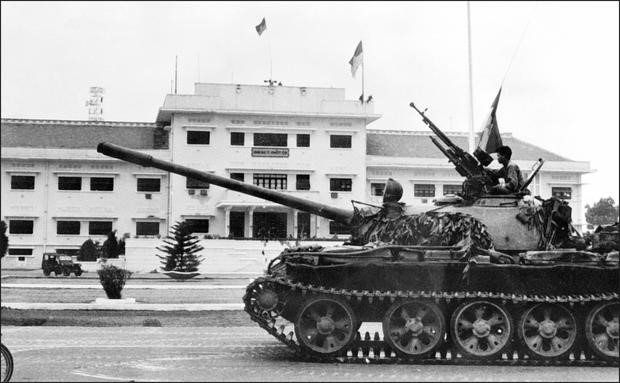
AFP/GETTY IMAGES
A soldier perched on a tank of the North Vietnamese Army (NVA) in Saigon, as the city falls into the hands of communist troops, April 30, 1975.
Fall of Saigon
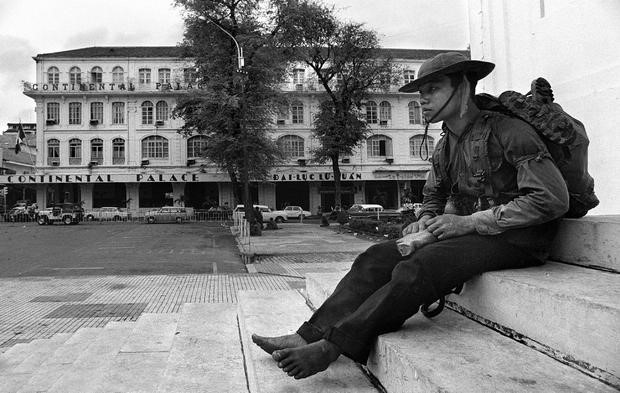
AFP/GETTY IMAGES
A soldier of the National Liberation Forces (NLF) of North Vietnam surveys the National Assembly building in Saigon, after the fall of the city, April 30, 1975.
Fall of Saigon

AFP/GETTY IMAGES
Duong Van Minh (C, looking down), the last president of U.S.-back Saigon regime, and his entourage leave the presidential palace in Saigon April 30, 1975 after announcing on radio his cabinet's surrender following his capture by North Vietnamese communist troops.
Fall of Saigon

AFP/GETTY IMAGES
Jubilant communist troops on top of trucks and APCs making their way to the center of Saigon as the city fell under their control, April 30, 1975.
Fall of Saigon

AFP/GETTY IMAGES
PRG forces seize control of the presidential palace in Saigon, after the fall of the city, May 3, 1975.
The Viet Cong created the Provisional Revolutionary Government of the Republic of South Vietnam (PRG) in 1969.
The war in Vietnam ended April 30, 1975 as the government in Saigon announced its unconditional surrender to the Vietcong.
Fall of Saigon
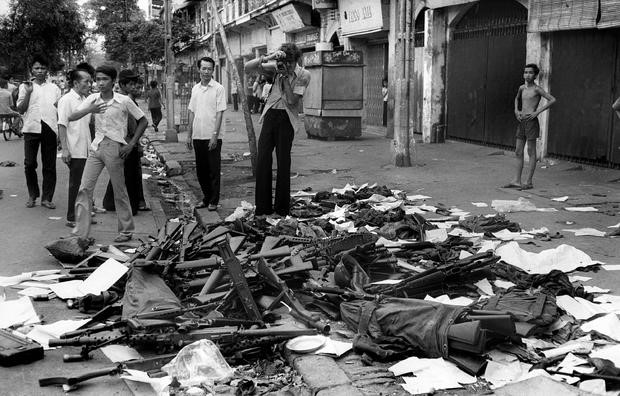
PHAM KHAC/AFP/GETTY IMAGES
Residents look at U.S. army guns collected in a Saigon street, after the fall of the city, May 27, 1975.
The war in Vietnam ended April 30, 1975 as the government in Saigon announced its unconditional surrender to the Vietcong.
Fall of Saigon

AFP/GETTY IMAGES
A National Liberation Front Army soldier (NLF) (L) patrols the streets of Saigon, after the fall of the city, 17 May 1975.
That NLF, formally known as the National Front for the Liberation of the South, was created by North Vietnam December 20, 1960 to effect the overthrow of the South Vietnamese government and reunification of North and South Vietnam. The Vietnamese communist party was later established in 1962 as a component of the NLF. The Viet Cong, the military arm, was part of the NLF.
First published on April 30, 2015 / 10:44 AM
BY RADHIKA CHALASANI
APRIL 30, 2015 / 10:44 AM / CBS NEWS



